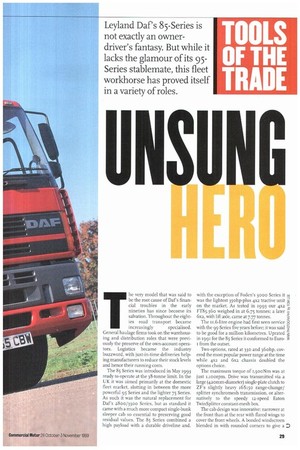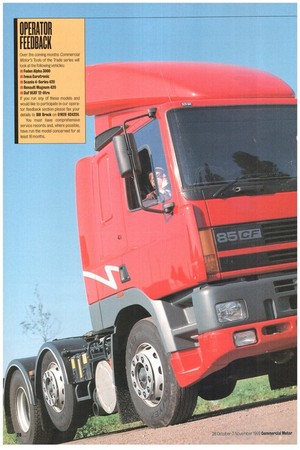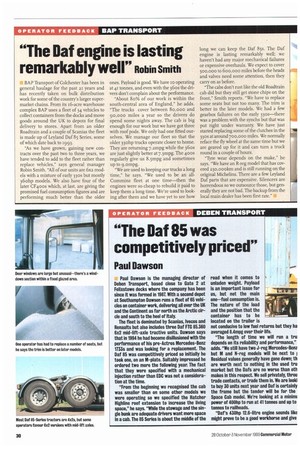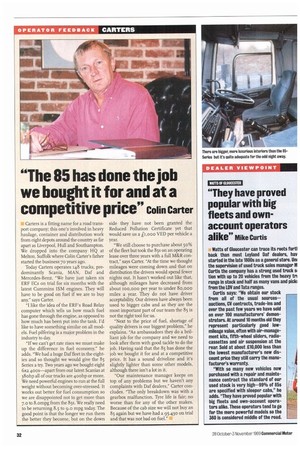TOOLS
Page 31

Page 30

Page 33

Page 35

Page 32

Page 34

If you've noticed an error in this article please click here to report it so we can fix it.
OF THE
TRADE
Leyland Daf's 85-Series is not exactly an ownerdriver's fantasy. But while it lacks the glamour of its 95Series stablemate, this fleet workhorse has proved itself in a variety of roles.
OPERATOR FEEDBACK
Over the coming months Commercial Motor's Tools of the Trade series will look at the following vehicles: r Foden Alpha 3000
lveco Eurotronic Scania 4-Series 420 Renault Magnum 420 Oaf 95XF 12-litre
If you run any of these models and would like to participate in our operator feedback section please fax your details to Bill Brock on 01628 624224.
You must have comprehensive service records and, where posstble, have run the model concerned for at least 18 months. The very model that was said to be the root cause of Daf's financial troubles in the early nineties has since become its salvation. Throughout the eighties road transport became increasingly specialised. General haulage firms took on the warehousing and distribution roles that were previously the preserve of the own-account operators. Logistics became the industry buzzword, with just-in-time deliveries helping manufacturers to reduce their stock levels and hence their running costs.
The 85 Series was introduced in May 1993 ready to operate at the 38-tonne limit. In the UK it was aimed primarily at the domestic fleet market, slotting in between the more powerful 95 Series and the lighter 75 Series. As such it was the natural replacement for Daf's 2800/3300 Series, but as standard it came with a much more compact single-bunk sleeper cab so essential to preserving good residual values. The 85 Series combined a high payload with a durable driveline and,
with the exception of Foden's 3000 Series it was the lightest 35ohp-plus 4x2 tractive unit on the market. As tested in 19 93 OUT 4X2 FT85,36 o weighed in at 6.75 tonnes; a later 6x2, with lift axle, came at 7.77 tonnes.
The tr.6-litre engine had first seen service with the 95-Series five years before; it was said to be good for a million kilometres. Uprated in 1991 for the 85 Series it conformed to EuroI from the outset.
Two options, rated at 330 and 36ohp, covered the most popular power range at the time while 4x2 and 6x2 chassis doubled the options choice.
The maximum torque of r,500Nm was at just Ltoorpm. Drive was transmitted via a large (420mm-diameter) single-plate clutch to ZF's slightly heavy 16515o range-change/ splitter synchromesh transmission, or alternatively to the speedy 12-speed Eaton TwinSplitter constant-mesh box.
The cab design was innovative: narrower at the front than at the rear with flared wings to cover the front wheels. A bonded windscreen blended in with rounded corners to give a D
MAIN PHOTOGRAPHY by TOM LEE
0 smooth front profile; even drip channels were omitted to ensure a clean flow of air over the roof. Flush door handles were mounted low down and faced rearwards so that they were less likely to collect dirt.
Door windows were large but unusual, containing a wind-down section within a larger glazed area. Two wide steps were staggered so that they could be seen from above to make dismounting safer. Inside, the cab included a driver's air suspension seat and adjustable steering column complete with a fold-down table. Cradling the engine within the chassis rails minimised intrusion into the cab to facilitate access across to the bunk area.
We felt that owner-drivers might be put off by the relatively small outside dimensions— in fact they belie the space available on the inside, but the trim had a definite "fleet" feel about it, with thick rubber mats in the footwells and dark grey fascia. On the plus side, the bunk was relatively thick and roomy while the window in the rear panel above it was double glazed.
Optional equipment included cruise control, road speed limiter and PTO control. The central warning system and night heater came as standard, as did the heated mirrors, but remote control was an option. The new stiff chassis incorporated a stronger front end to withstand the static steering forces envisaged for an 8.5-tonne front axle in place of the standard 7.5-tonne steer axle. The rear steel suspension with anti-roll bar was said to be road friendly but four-bag ECAS electronically air controlled suspension could also be specified (and usually was). It could be raised or lowered to suit docking or trailer coupling heights, either from the cab or from the side D
of the vehicle using remote control. A 67o11t/min compressor delivered air at i o.o bar instead of the more usual 8.o bar. The higher pressure meant one less air tank was needed and it gave a little extra bite to the conventional drum brakes, which featured Category! ABS control.
In 1993 we recorded an overall fuel consumption of 7.56mpg which was just a mite below par. In 1996 a power rating of 4othp was added to the range, which by now met Euro-2. This version of the ii.6-litre engine still used mechanical injection technology but the performance profile was altered so that maximum torque of t,64o N m was delivered at a slightly faster engine speed of 1,500rprn to give a wider economical operating band.
With the introduction of the 85 CF last year Daf moved to a 12.6-litre, 24-valve engine, borrowed from the 95XF, with power options at 340, 381 and 428hp and an engine brake. When tested by CM it returned 8.5mpg; almost 12.5% better than its predecessor. Now that's what we call progress.
IN by Bill Brock
OPERATOR FEEDBACK
BAP TRANSPORT
"The Daf engine is lasting
remarkably well" Robin Smith BAP Transport of Colchester has been in general haulage for the past ZI years and has recently taken on bulk distribution work for some of the country's larger supermarket chains. From its 16-acre warehouse complex BAP uses a fleet of 34 vehicles to collect containers from the docks and move goods around the UK to depots for final delivery to stores. Apart from an older Roadtrain and a couple of Scanias the fleet is made up of Leyland Daf 85 Series, some of which date back to 1993.
"As we have grown, gaining new contracts over the past two to three years, we have tended to add to the fleet rather than replace vehicles," says general manager Robin Smith. "All of our units are 6x2 models with a mixture of early 330s but mostly 360hp models. We also have four of the later CF400s which, at last, are giving the promised fuel consumption figures and are performing much better than the older ones. Payload is good. We have to operating at 41 tonnes, and even with the 36os the drivers don't complain about the performance.
"About 8o% of our work is within the south-central area of England," he adds. "The trucks cover between 8o,000 and 90,000 miles a year so the drivers do spend some nights away. The cab is big enough for our work but we have got three with roof pods. We only had one fitted ourselves. We manage our fleet so that the older 33ohp trucks operate closer to home. They are returning 7.2mpg while the 3608 are just slightly better at 7.3mpg. The 4005 regularly give us 8.5mpg and sometimes up to 9.0mpg.
"We are used to keeping our trucks a long time," he says. "We used to be an allCummins fleet at one time—then the engines were so cheap to rebuild it paid to keep them a long time. We're used to looking after them and we have yet to see how long we can keep the Daf 85s. The Daf engine is lasting remarkably well; we haven't had any major mechanical failures or expensive overhauls. We expect to cover 5oo,000 to 600,000 miles before the heads and valves need some attention, then they carry on as before.
"The cabs don't rust like the old Roadtrain cab did but they still get stone chips on the front," Smith reports. "We have to replace some seats but not too many. The trim is better in the later models. We had a few gearbox failures on the early 3305—there was a problem with the synths but that was put right under warranty. We have just started replacing some of the clutches in the 3305 at around 700,000 miles. We normally reface the fly wheel at the same time but we are geared up for it and can turn a truck round in a couple of hours.
"Tyre wear depends on the make," he says. "We have an R-reg model that has covered 2.3o,000km and is still running on the original Michelins. There are a few Leyland Daf parts that are expensive. Silencers are horrendous so we outsource those, but generally they are not bad. The backup from the local main dealer has been first rate.
OPERATOR FEEDRAc A
DEBEN TRANSPORT
"The Daf 85 was competitively priced"
Paul Dawson
Paul Dawson is the managing director of Deben Transport, based close to Gate 2 at Felixstowe docks where the company has been since it was formed in 1987. With a second depot at Southampton Dawson runs a fleet of 65 vehicles on container work, delivering all over the UK and the Continent as far north as the Arctic circle and south to the heel of Italy.
The fleet is dominated by Scanias, Ivecos and Renaults but also includes three Daf FTC 85.360 6x2 mid-lift-axle tractive units. Dawson says that in 1994 he had become disillusioned with the performance of his pre-Actros Mercedes-Benz 1733s and was looking for a replacement. The Daf 85 was competitively priced so initially he took one, on an M-plate. Suitably impressed he ordered two more the following year. The fact that they were specified with a mechanical injection rather than EDC was not a consideration at the time.
"From the beginning we recognised the cab was smaller than on some other models we were operating so we specified the Hatcher Highline roof extension to increase the living space," he says. "While the stowage and the single bunk are adequate drivers want more space in a cab. The 85 Series is about the middle of the road when it comes to unladen weight. Payload is an important issue for us, but not the main one—fuel consumption is. The nature of the load and the position that the container has to be located on the trailer is not conducive to low fuel returns but they ha averaged 8.4mpg over their life.
"The length of time we will run a tru depends on its reliability and performance," adds. "We still have two J-reg Mercedes-Benz but M and N-reg models will be next to I Residual values generally have gone down; th are worth next to nothing in the used tru market but the Dafs are no worse than 0th makes in this respect. We sell privately, throu trade contacts, or trade them in. We are looki to buy 30 units next year and Daf is certainly the frame but the tender will be for the Space Cab model. We're looking at a minim( power of 400hp to run at 41 tonnes and up to tonnes to railheads.
"Oaf's 430hp 12.6-litre engine sounds like might prove to be a good workhorse and give ie mpg figures we need," says Dawson. "The 85s iver about 90,000 miles a year and all three are ivered by contract maintenance carried out by ie main dealer, Chassis-Cab, which is 12 miles vay at Ipswich. They service them overnight. aintenance costs are fairly low. There are no dden costs and the price is set for a given ;Hod of time. It's in the dealer's interest to look ter the truck and do the job properly first lie. Drivers fill in a defect book and most things rlie to my attention.
"Not all jobs can be completed overnight," he tys, "but the Dafs have never been in the worklops for a significant time and we haven't had le break down on the road. Reliability has been Id and fuel consumption is average. Dealer tckup has been very good and is a prime reason iy we will be considering Dafs in the future."
RECALLS
The Vehicle Inspectorate's Safety Branch has issued a number of safety-related recalls for the Leyland Daf 85 Series.
Build date July-November 1993: Spring saddles on tandem axles might crack.
Build date March 1993-November 1994: Failure of T-adaptor on front brakes might result in reduced braking effort.
Build date December 1993: Propeller shaft couplirg hols might loosen.
Build date January-December 1995: Debris might enter the induction system and ignite.
Build date February-May 1995: Power steering hose might rupture.
Build date February 1996: The power steering mignt Build date April-June 1996: Air might leak from the air system.
Build date June 1997: The front axle U-bolts might crack.
Build date September-December 1997: Steering box might loosen.
Build date September 1997-March 1998: Possible failure of seat-belt locking mechanis—.
Build date February-September 1998: Steering column lower retaining bolt might fail.
Build date to October 1998: Steering drag link and track rcd end might loosen, Build date January-May 1999: Potential steering Licx t ure.
TOOLS
OF THE TRADE SPECIFICATION
Leyland Daf FT85.360 4x2 tractive unit with ngleibuok sleeper cab. Design GCW: 44.0 tonnes. Resign GilW: 19.0 tonnes. Manufacturer: Leyland Daf Trucks, Eastern 3ypass, Thame, Oxon 0X9 3FB.
ENGINE
Oaf WS268L Eurol charge-cooled turbodiesel with EGAS electronic cruise control Cylinders: Six, In line.
Capacity:11.6 litres,
Maximum net power: 364hp (242kW) at 2,000rom.
Maxiiimm net torque: 1,500Nm (1,106Ibft) at 1.100-1,200 rpm.
TRANSMISSION
7116S150 16-speed Ecospit with rangechange and splitter. Air-assisted, 420mmdiameter single-dry-plate clutch.
Final drive: Daf 1346 single-reduction axle with diff-lock; ratio, 3.31:1.
BRAKING SYSTEM
Dual-circuit, ABS category-1 full air system with auto slack adjusters, dryer and driveaxle load sensing.
Darlcint Spring brake actuators on drive axis.
STEERING TRW integral power assistance.
CHASSIS Ladder construction with riveted and bolted cross-members,
Suspension: Front, parabolic steel springs with anti-roll bar; rear, Daf four-bag air suspension with ECAS electronic control Axle design **gilt& Front. 7.5 tonnes; rear, 11,5 tonnes.
Wheelbase: 3.5m.
Wheels and tyres: 22.5 steel rims with 295/80 tyres front and rear.
Fuel tank: 500 litres.
ELECTRICAL SYSTEM
24V, 2x1,35Ah batteries with 55A alternator.
SERVICE DATA
PARTS PRICES
Vantrfacti iren's prices( retail ex-VAT): Laminated windscreen: '2109.30 Injector set (six, service exchange): £173.40 Piston liner set isix)'. 11,069.00 Rear spring brake chamber: £195.64 Complete headlamp unit: £110.80 Wiper blades !complete set): £30.90 Engine oil fitter: 718.01 Complete clutch assembly (exchange): Doer mirror (glass): £19.94
WORKSHOP TIMES
'‘,+arufacturer's standard wortishor. hours Remove and replace clutch assembly: 4.45. Remove and replace all injectors: 2.10 Replace head gaskets (both): 11.20 Replace brake shoes, front and rear: (20 Remove and replace engine: 0.30 Remove and replace gearbox: 4.80 Renew engine oil inert s): '1i
"The 85 has done the job we bought it for and at a
competitive price" Colin Carter
Carters is a fitting name for a road transport company; this one's involved in heavy haulage, container and distribution work from eight depots around the country as far apart as Liverpool, Hull and Southampton. We dropped into the company HQ at Melton, Suffolk where Colin Carter's father started the business 70 years ago.
Today Carters operates 148 trucks, predominantly Scania, MAN, Daf and Mercedes-Benz. "We have just taken six ERF ECs on trial for six months with the latest Cummins ISM engines. They will have to be good on fuel if we are to buy any," says Carter.
"I like the idea of the ERF's Road Relay computer which tells us how much fuel has gone through the engine, as opposed to how much has been put into the tank. I'd like to have something similar on all models. Fuel pilfering is a major problem in the industry to day.
"If we can't get rate rises we must make up the difference in fuel economy," he adds. "We had a huge Daf fleet in the eighties and so thought we would give the 85 Series a try. Two years ago we bought eight 6x2 400s—apart from our latest Scanias at 38ohp all of our trucks are 400hp or more. We need powerful engines to run at the full weight without becoming over-stressed. It works out better for fuel consumption so we are disappointed not to get more than To to 8.ompg from the 85s. We really need to be returning 8.5 to 9.0 mpg today. The good point is that the longer we run them the better they become, but on the down
side they have not been granted the Reduced Pollution Certificate yet that would save us a £1,000 VED per vehide a year.
"We still choose to purchase about 50% of the fleet but took the 85s on an operating lease over three years with a full M8412. contract," says Carter. "At the time we thought mileages were coming down and that on distribution the drivers would spend fewer nights out. It hasn't worked out like that, although mileages have decreased from about I00,000 per year to under 8o,000 miles a year. They do not have driver acceptability. Our drivers have always been used to bigger cabs and as they are the most important part of our team the 85 is not the right tool for us.
"Next to the price of fuel, shortage of quality drivers is our biggest problem," he explains. "As ambassadors they do a brilliant job for the company and we need to look after them with good tackle to do the job. Having said that the 85 has done the job we bought it for and at a competitive price. It has a sound driveline and it's slightly lighter than some other models, although there isn't a lot in it.
"Our maintenance manager keeps on top of any problems but we haven't any complaints with Daf dealers," Carter concludes. "The only breakdown was with a gearbox malfunction. Tyre life is fair; no worse than for any of the other makes. Because of the cab size we will not buy an 85 again but we have had a 95.43o on trial and that was not bad on fuel."
WATTS OF GLOUCESTER
"They have proved popular with big fleets and own account operators
alike" Mike Curtis
Watts of Gloucester can trace its roots furtl back than most Leyland Dal dealers, hay started in the late 1800s as a general store. Uni the supervision of used truck sales manager M Curtis the company has a strong used truck si tion with up to 20 vehicles from the heavy tri range in stock and half as many vans and picki from the LDV and Tata ranges.
Curtis says: "We obtain our stock from all of the usual sources— auctions, CV contracts, trade-ins and over the past few years we have sold on over 100 manufacturers' demonstrators. At around 10 months old they represent particularly good lowmileage value, often with air-management kits, fifth-wheel sliders, radiocassettes and air suspension at the rear. Sold at about £10,000 less than the lowest manufacturer's new discount price they still carry the manufacturer's warranty.
"With so many new vehicles now purchased with a repair and maintenance contract the standard of our used stock is very high-99% of 85s are specified with sleeper cabs," he adds. "They have proved popular with big fleets and own-account operators alike. These operators tend to go for the more powerful models so the 360 is considered middle of the road.
le later CF is better on fuel and over the past tar we've seen a number of customers buy late w-mileage models rather than waiting for !liveries of new ones.
"But the 85 is a long-life truck," he says. "We m sell models up to six years old with a power'ain warranty. Within the used truck market we re still selling more 4x2s than 6x2s. Over the ist 12 months we have sold 70 4x2 85 Series 'active units against just 18 6x2s. It's quite dif:rent with new vehicles where the 6x2s are early outselling the two-axle tractive units. !me of the 4x2s are converted with mid-lift des and the Hatcher roof conversion can be !ecified to extend cab space."
Asked about prices, Curtis reports: "A 1997 4x2 115 360 with 230,000km retails at about £24,750 id for a 6x2 you can add another £2,500. The ctra axle on the later CF models demands 'ound £6,000 more."
COMMERCIAL VEHICLE AUCTIONS
"We get a lot of interest from tipper operators"
Chris Wright
Chris Wright, managing director of Commercial Vehicle Auctions, runs sales twice a month at his Doncaster site and stages auctions at customers' bases round the country.
"If what happens in the market-place is any indication of how a truck performs then the Leyland Oaf 85 Series is a good truck," he says. "They are fairly plentiful— we have 10 tractive units in our next sale, registered between 1993 and 1996. The 360hp model is favourite as we don't see so many of the later 400s yet.
"Contrary to the position with most trucks, the 85 4x2 tractive unit is fairly easy to sell," Wright adds. "We get a lot of interest from tipper operators, who find the size makes them manoeuvrable and they don't mind the smaller cab interior. We have also sold quite a few 85.330 4x2 daycab models—many of those have gone for export. For the home market the swing is still towards 6x2s. The driveline is fairly sound but the seats and trim on early examples can get a little tatty.
"The quality improved on later models. Last month we sold a 1995 85.360 4x2 on an N-plate for £12,500 while a 6x2 version, still on an N but registered a year later, sold for £18,500. Because there are fewer 6x2 85 Series in the market-place and demand is higher they command a premium of around £4,000 over the price of an equivalent 4x2 unit."
oir
OF THE TRADE
VERDICT
Leyland Daf's 85 series has been around for a long time. As it has been improved and become more established its popularity has grown. Lower powered used examples are less in demand, especially since the introduction of the 41-tonne weight limit; for the same reason 6x2s fetch a premium. Following some teething problems with the ZF gearbox the reputation of Leyland DaPs driveline is rock solid. The engines run and run; the latest versions provide the best fuel returns. And with sympathetic use the single-plate dutch can run longer than the engine before it needs attention. Most 85s come with a sleeper cab but its relatively small dimensions make this truck best suited to domestic operations and a niche market has developed among tipper operators. If a roomier cab is needed for other types of operation the 95 Series will provide all you could ask for.
INSURANCE
ge Insurance broker Roberts and Davis of Newmarket supplied us with a sample quote of 1,986 for an owner-driver with full no-claims benefit operating within the UK at 41 tonnes.
















































































































